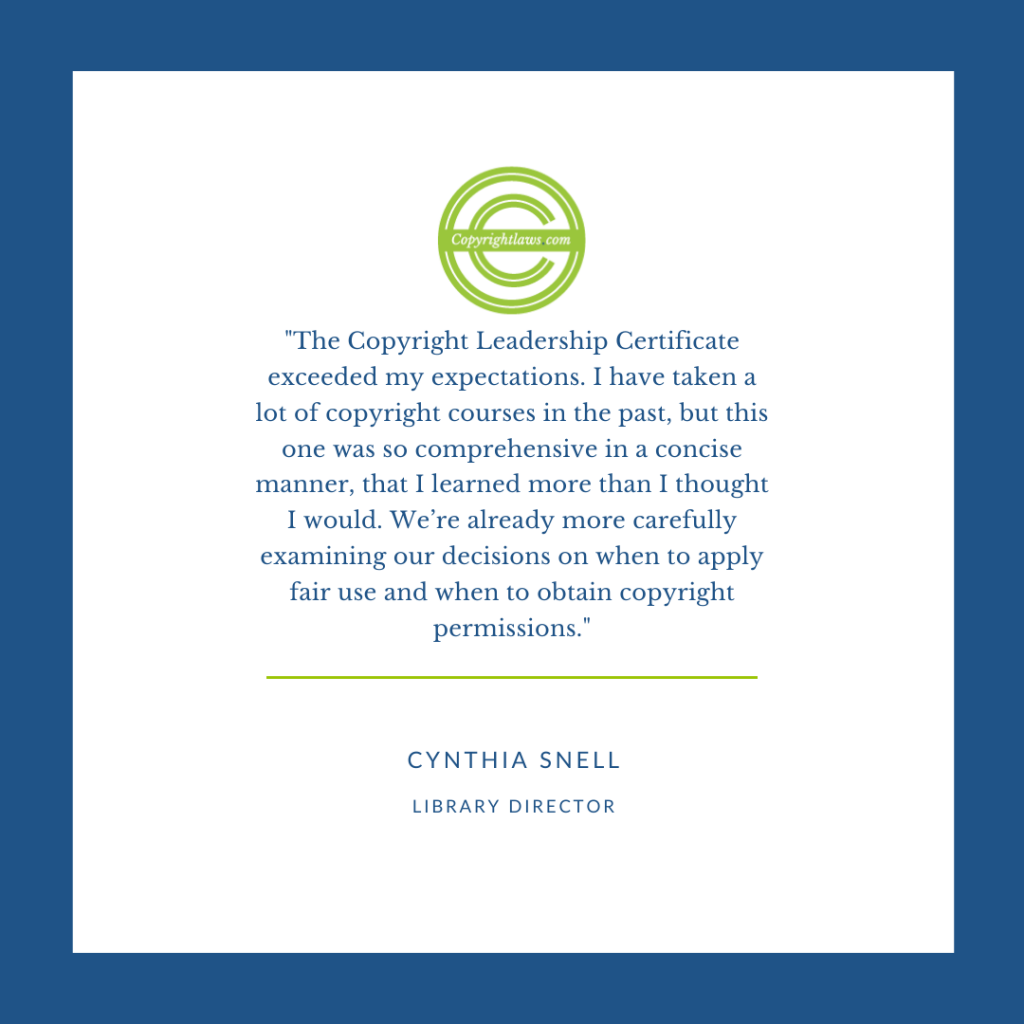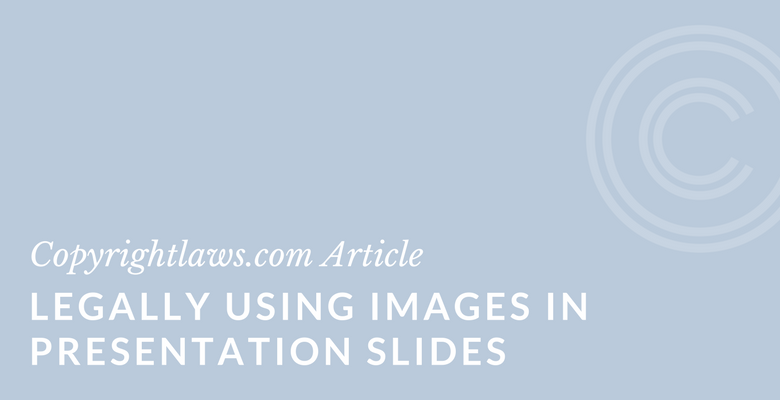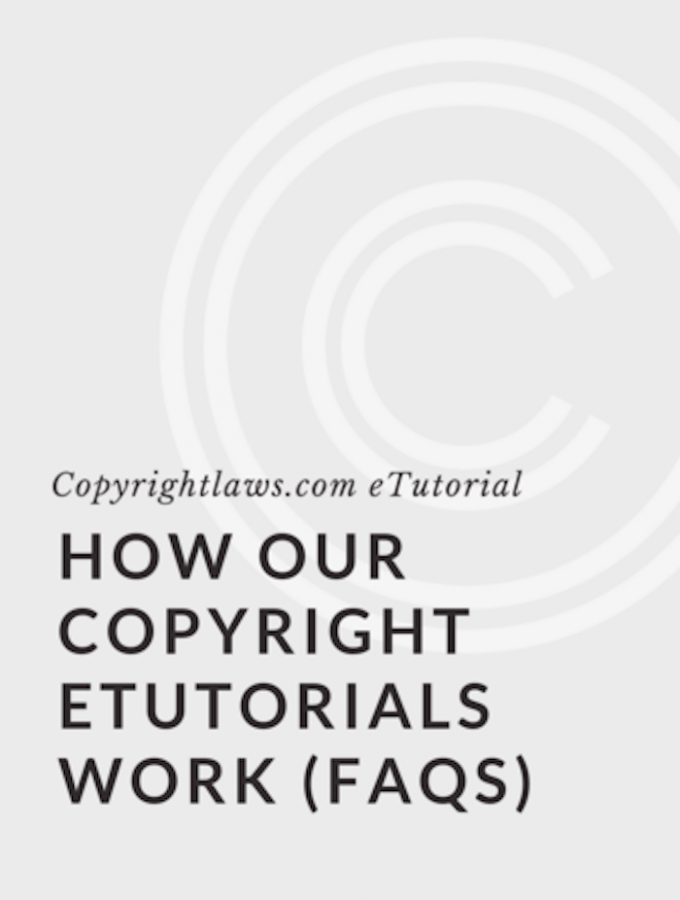Do you use images in presentations? Whether an in-person or virtual presentation or class, this article will help you establish best practices for legally using images in presentation slides and minimizing your risks of copyright infringement. Images include photographs, charts, maps, illustrations, charts and more. You may also like our online copyright course that includes an entire module on legally using images.
Scroll down to the end of this article to download
our Simple Guide to Legally Using Images in Presentations.
Are You Legally Using Images in Presentation Slides?
How much attention do you pay to copyright law when you create slides for a presentation? While it's important to focus on the non-legal aspects of the presentation such as content and images to enhance speaking points, it's just as important to consider copyright issues. Here are some tips to get you started:
- Include copyright management as a regular part of planning your presentations
- Incorporate a permissions process into your planning
- Be aware of your budget, if you have one, to pay for permissions
- Plan for the possibility that if you're unable to secure permissions on time or the fees are too high, you'll need to adjust your content accordingly
As with most copyright issues, the matter of legally using images in presentation slides is nuanced. The answer to many questions is often “it depends” or "maybe" or "let's examine your particular circumstances." Understanding copyright issues will help ensure you're legally using images in presentation slides.
First Ask Yourself: Are the Images Protected by Copyright?
When you find an image online or elsewhere, assume it's protected by copyright. Once you identify the image you want to use, consider its copyright status and whether you need permission to use it.
Google has made it easier to determine an image's copyright status by providing copyright-related metadata for images in Google Images, when this information is available. To learn more, see Google’s article Image Rights Metadata in Google Images. Note that some images don't have this metadata and you'll need to do further research.
How Can You Avoid Copyright Concerns When Using Images in Presentations?
There are several ways to legally use images in presentation slides that don't require you to clear copyright permissions with the images' copyright holders.
Use Public Domain Images
If you determine that copyright in a work has expired and the work is in the public domain, you can use the work without obtaining permission. In the U.S., a work is in the public domain 70 years after the author's death. Most countries have a copyright duration of 50 to 70 years after an author's death.
Be mindful that a work that's been manipulated or adapted may constitute a new work. That new work may have a new and longer copyright duration, even though the underlying work is in the public domain.
State or Summarize Facts, News and Historical Events
You may state or summarize facts, news and historical events without permission as long as you don’t reproduce them exactly as you found them in the source.
This basic principle of copyright law works for text but is more difficult to apply to the use of images. You could, however, use data or summarize it rather than reproduce, adapt or share a source table or chart without permission.
Create Your Own Images
Instead of using third-party content, another way of legally using images in presentation slides is to use a chart or photograph that you or a fellow employee created. An employer generally owns the copyright in any works its employees create during the course of their job duties. So, keep in mind that if you take a photo as part of your employment duties, your company likely owns the copyright in it.
Employers, however, should be aware that you don't own copyright in everything created by your employees. You only own copyright in those works created as part of an employee's duties. So even if an employee posts a vacation photo on your organization's website, you likely don't own the photo if it wasn't created as part of their required duties.
Use a Stock Photo Agency
Your organization may have an account with a stock photo agency where you can find images that suit your purpose. You must follow the terms and conditions of the agency's license agreement to legally use these images in your presentation. Familiarize yourself with the license your stock photo agency uses (e.g., see the iStock Content License Agreement).
Use Images with a Creative Commons (CC) License
Just because an image has a Creative Commons license doesn't mean you have unrestricted use of it. Read that license! Does it specifically allow your use of the image? Review the terms and conditions of the CC license to ensure your use complies.
Tips for using images governed by CC licenses:
- You need to acknowledge the author of the image
- Read the terms and conditions of the CC license to see what's permitted and what requires further permission
- CC licenses are irrevocable, so you can use the image under the license as long as you need to
Don't Rely on Prior Copyright Permissions
If you already have permission to include a photograph in a management training session at your company’s headquarters in Baltimore, it doesn’t mean you can use that photo in a public presentation being made across North America. Know the terms of licenses and assignments (i.e., permissions). If they don’t apply to the current situation or current presentation, either seek additional permission or use an alternative image.
Use Images As-Is
Even if you have permission from the copyright owner, you may need specific permission to re-color, make black and white, or color, crop or otherwise manipulate images. Standard stock photo agency licenses, for example, may not allow these additional uses without further permission.
Does Fair Use or Fair Dealing Apply to Using Images in Presentation Slides?
Fair use or fair dealing provisions may apply to your use of images in your presentation, permitting you to reproduce a work without permission in some situations. You’ll have to apply the fair use or fair dealing criteria to your particular situation to determine if it falls within these statutory provisions.
Fair use and fair dealing are not without risk. The only way to know for certain if your fair use or dealing assessment is correct is in a court of law. It's wise to know your organization’s risk tolerance for an inaccurate fair use or fair dealing determination. It's also advisable to consult internal policy, a copyright specialist, and/or your legal counsel on these matters.
Familiarize Yourself with Copyright Law
Everyone needs to be familiar with the basics of copyright. Whether you’re designing presentations, writing the company newsletter, or photocopying materials, copyright should be part of your workflow. To understand how to legally use images, concentrate on:
- What images are protected by copyright law
- When you need to obtain permission to use images and when you can use images without permission or additional permission
- Additional rights to consider when legally using images, such as moral rights that protect the paternity and integrity of an author, and privacy rights
You may also be interested in our article on obtaining permission to use comic strips, as well as Copyright Issues in E-Books and Electronic Publishing.
Want more helpful information like this? Our Copyright Leadership Certificate program provides a primer on U.S. and global copyright law, devotes an entire course to legally using images, and teaches you practical skills to interpret copyright in your workplace.

If the form above doesn't work, please follow this link to sign up.




